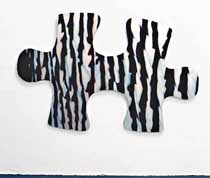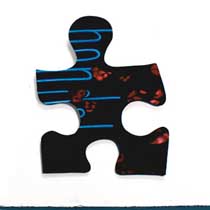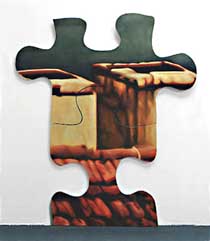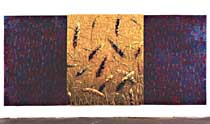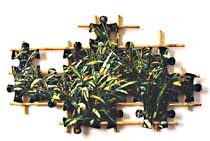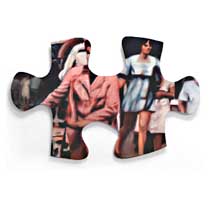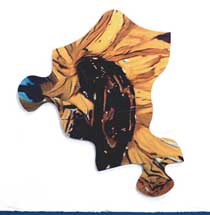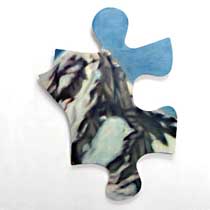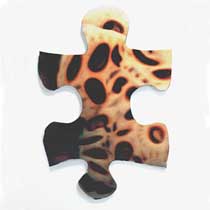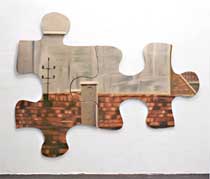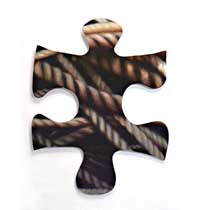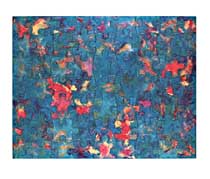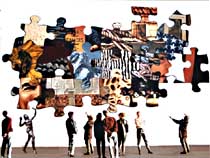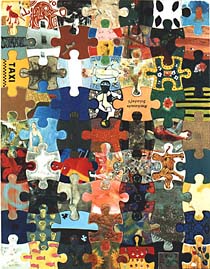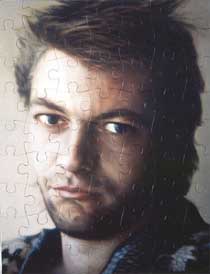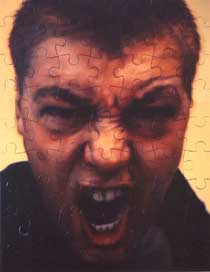m e i n o . d e
...german...
"The residentness in the usual one is however the noneworking of hiding the hiding. There is unexplained, questionable also in the passable mystery, but these of their even safe questions are only passages and intermediate places for the courses in the passable one and therefore not substantial. Where the secrecy of being, in the whole one, only like occasionally an announcing boundary becomes certified, hiding sank as basic event in the oblivion."
(Martin Heidegger)
"Our perception becomes liquid and more flexible, if we penetrate into deeper consciousness layers, dreams, fantasies, under smoldering leagues conceptions or the fantastic visions of the creative status. It extends its focus, in order to enter expanded structures. This different distinctionlayers in our perception are among themselves in a constant interrelation, not only during the enormous reversal of dreaming for being awake, but also with the rapid back and forth from differentiation and dedifferentiation, which undiscovered constantly pulsate through our daily life. It is extremely difficult to get those between the sharp pictures of our conscious memory here and there available gaps, in which a dream-similar ambiguity prevails and which is more broadly strewn attention, into the grasp. It probably presupposes a special capability to in-look to the own consciousness stream and consider on the innumerable twilight statuses between the sharply outlined shape structures of our memory or rather to restore them. Freud assumed, the memory registers only the periodic (shape -) crystallizations in the consciousness stream, and the undifferentiated gaps were once and for all lost - a strange acceptance for the founder of the Psychoanalyse, who on the other hand the post effect long lost memories and the timelessness of the unconscious one announced."
The german pendant for sublim is the Erhabene, this - how I mean - somewhat
pompous word describes a feeling status, which is in the reason nevertheless
quite clear and unique. Only by the philosophical view and the verbal,
rational description attempts will the term complicated and encoded and
saves due to this ratification and containment the danger, to be protact
or missed and thus set up for independent itself, only be a play meadow
of the philosophers. On this play meadow now is already struggled in over
two thousand-year old tradition, to fathom the essential structure of a
complex intercultural phenomenon, with the probably still secret longing
of strukturalen linguistics and anthropology, itself the proteistic processuality
of the world by means of always new rules (out-maneuvered thereby one halfway
passably still from an offside position), to seize by means of formulaful
reductions to a certain extent to a original law. One of the most industrious
coaches is probably Kant, who sets up an effective tactics, but he must
gave his players always new sprags and prostheses.
With the Erhabene by Kant the sensual and the transcendental
fortune meet one another directly. With this dialectic structure a transition
problem with the faint and questioning of the subject is joined in view
of over-powerful nature. The " listlessness " on the one site, on the other
hand a " desire ", which results reflecting from a reason idea relating
to self protection. The Erhabene remains a feeling contradictory in itself,
a paradox. With the raised one thus always one occurs like the other one,
both at the same time, the listlessness and the desire, the irrationality
and the rationality, the negation and the affirmation, the empirizity and
transcendentality, criticism and metaphysik, chaos and order, abyss and
transition. It marks the boundary between the extremes, blocks the acces
on the one hand, extended however the view of the other one.
This indissoluble, belonging to the Sado-Masochisti, going into one
another from fear and desire, from and over powerful wools drives also
me to it, the inexpressible to show and the perceptible suspect. In order
to have here a valid, true raised one non--I base (- paradoxically, there
I on inner worths look nevertheless), in order to thus arrive at the border,
origin of my imagination, my discretion, I put to my work - " similarly
as Kant - the beauty of nature as the base.
The beauty of nature consists now however only of one not comprehensible
complexity and an impressing inexpediency. As soon as I subordinate it
now to an appropriateness, in order to make it accessible for my understanding,
seize it into terms , make distinctions, nothing remains more from the
true beauty - I move only in my own definition space.
It is impossible to decode the landscapes, to expose it conceptually.
They are alone accessible over the feeling. Everything in nature, everything
that we cannot understand, is " trueful beautifully ", indescribably, on
an equal footing, it`s fact. If we feel something as " ugly ", then this
results to only from an empirical fear, possible an instinct, or because
it does not gnaw tied at the boundaries of our understanding. " beautiful
" and " ugly " are only terms, which rise from an appropriate understanding
definition, and we can apply them only to (art)works, which were created
also even by this simple understanding. How more intention/rule behind
it is to create something beautiful ,how fewer of that "true beauty " will
be remaining. -This does not mean that, if I make somewhat ugly it becomes
beautiful then. The beautiful will felt as pleasant, because it does
not load the spirit, and the opportunity offers to the pure reflexive (indifferents)
judgement to arrive up-to-date at the execution.
A complex definition framework adheres to the term of the aesthetics
by the numerous endless philosophical views, in which it was revoked and
extended again and again.
Like that it is only a small step of the double aesthetics carried
forward implicitly by John Denis to Joseph Addison, who separates some
years later the raised of the beautiful, and thus should give to
the aesthetics of the18. Century their substantial pair of categories.
In my text I call with aesthetics fewer an ethical as a formative,
visual, harmonious beauty in the art-aesthetic sense. Today an openly thinking
art viewer hardly doubts the aesthetics of scribbled pencil line on a cheap,
printed calendar page paper, decoreted with grease mark (he doesnīt
have to). I show on the basis my work that the term of the aesthetics is
not only very flexibly, but perfectly unnecessary in the traditional academic
sense.
Aesthetics can refer only to form, material, colour, mark way, motive,
composition or abstraction (recognize). I will now define these individual
categories on the basis of my work. Overlaps of this allocation occur also
again and again, which shouldnīt however tempt to hope for
the presence of an aesthetics formula.
Already since the turn of the century artists require the detachment
from the classical thought categories of the view of picture. The Dadaisten,
often already freely of image carriers, and the Kubisten with " polydimensionaly
" opinions, but arrested still aesthetically on the canvas.
The black square of Malewitch is the cleaned image plane, on which
all conceivable one can appear: an imagination surface, on which the characters
and graphisms can be entered freely, on which each line as wound and each
picture as over painting becomes recognizable, which protect at the same
time against the infinity and refer to it. Which constitutes here the unit
of logic, appearance, gleam and secret of the world, is already alienated
by the analytic burst tests in the cleaned knowledge and image spaces into
its tautological blank characters.
In my analysis of the picture world I have logical first dealt myself with the image carrier. Most concisely the breakup of the chains from the centuries long brought square form of the board picture, is shown by the open puzzle section form. This form saves the elucidation of anyness of the form with its various variations. Even for dogmatisch assessed humans, the puzzle form facilitates the detachment of the traditional board picture and the entrance into a new view dimension, cause this form is familiar since childhood days. If one begins now to detect in place of a " missing " puzzle play section also a picture, one learns to discover this, freely from each form, also on different place - everywhere -.
It proves with Duchamps "Ready-made" objects as appropriate to adhere
as close ones as possible to the reality and, the way already free from
personal, artistic intentions, to place the term of the aesthetics within
the forming art in question. Thus I tried to paint the respective sections
as free as possible by manierierted artistic orgasm. To this " van Gogh-Syndrom
" I mention later in greater detail with the puzzle of reproductions of
his "sunflowers".
In order to revoke a further artistic domain, I made the condition for me to select even the motive at any will. Thus I operated freely after the Dadaist -, in the " Cabaret Voltaire " their poems wrote, by mixing chads with words on it on the desk and sorting the poem in the order, how they pulled the chips. I spread thousands of puzzle section on a table, drew one and paint it then, on a descriptive measure increased. Also the printing-specific inadequacies were along-painted by me, since I would not dare to imitate nature. There are thus always reproductions of reproduced nature/reality.
The comparison to the Pop-art, in particular to Andy Waarhol with his "reproductions" of popular consumer pieces is quite intended with this play of the reproduction . Here the repeated conscious alienation of the alienation becomes clearly by second reflection. The tradition up to the Renaissance teaches that the new in art, which settles in particular in the understanding of the imagination or the fantasy, only can be one combination out of already existing impressions or circumstances, an assembly thus like a fabulous creature, which is assembled from the sections of different animals. The painting copies thus not the idea of something, separate it illustrate already imitations.
Platon shows the comparison with the mirror, with which everyone can simulate the Demiurg, points to the fact that for it the trueful imitation is inseparably connected with the knowledge around the imitation : "It goes completely easy and is often applied. Fastest, if you want to take a mirror and carry him everywhere. Rapidly you can create the sun and the world of the sky, rapidly the earth, rapidly you and all animals and devices and everything that we enumerate evenly." "Yes, as images, not as real and trueful existing." " Very well! You come even there, where those question you needs. Because to these masters also the painter belongs. Not?" " Without doubt." " Not trueful, there you will object; meanwhile somehow also the painter creates a chair. Not?" "Yes, even if only an apparent." " How the painting behaves to each thing? Create it imitations after the real object or after its appearance, so it is thus imitation of the reality or the shine of picture?" " The shine of picture." " Far away from thus the art of the imitation is to the truth, and even creates it everything after, because she enters only little from each thing and there only its shine picture."
Humans of the prehistory tried to compensate their distribution to powers of nature, by avoiding threatening natural occurences by terms. In the definition of nature on terms the unit according to experience separated from picture and term. Humans stepped at the same time opposite the nature objects as definition-moderate subject and put themselves into the position to make nature the means of their purposes. In the narration (greek. mythos) humans formed nature after their picture. In it the inlightened page of the myth was situated justified for Horkheimer/Adorno. It is now crucial that the enlightened reason integrated this mythologic - on subjecting power based - structure in itself, instead of bringing itself reflexiv broken to consciousness. Therefore still are nature, also the internal-human, faced the reason as something endangering. This threat the reason gets rid of by rising rationalization of all areas of life.
*
Vincent van Gogh is considered probably absolutely as a obsessiver painter
with personal printout, gesture, duktus and which otherwise still belongs
to it. Everyone means to know his sunflowers, whereby it painted different,
and it is talked and written already immensely much about him and evenly
these picture(s). We all know these, "sunflowers" from reproductions -
lucky those, which saw them in the original. The chance ever to get it
to face is probably very small, there this milestone of the history of
art - it appears to me as pure derision and at the same time significantly
for our time - slumbers surely guarded in any safe deposit as value
system. I found it only obvious to deal with these sunflowers in my puzzle.
Thus I procured myself several reproductions, and, as was it shown, nothing
remained except differenten grey tones of the "duktus". Particularly striking
were the differences in color of these reproductions. Thus almost again
the entire chromatic spectrum was to me for my work at the disposal.
It is thus still the question: " Which (aesthetic) reason has this
picture for the viewer, except that he knows that it is expensive and van
Gogh lived a tormented life, may be intensive for him, at the edge
of its vital possibility.
In the civil society, particularly for the romantic, art plays also
the role of the another to the presence. It was considered as looking at
future truth, as appearances of another society, as reconciliation of culture
and nature, as memory of the displaced or as objection against the system.
However this different one, this transcendented was understood, then this
position, -one has thought only of the genius cult developed at the same
time-, has the artist a special role awarded. Flares between the martyr
at the society and the guardian of the other one, that let the art become
ever more a substitute- and escape dimension. But one must ask oneself
nevertheless here: substitute dimension for which and escape dimension
to where?
Surely are, since the days of of the stone-temporal cult caves, where
the art connected still lives and death, earth and sky, open-endedness
and orientation, history and nature, human life and starways to interpretations,
which should permit to arrange the appropriate relationship, some from
the metaphysischen forces lost, - which would be capable perhaps for all
global well-being sound of providing -, or even in one of the rear drawers
of our brain stored.
One knows the artist as guardian of the Grals. Can we still charge
him another special role, approximately as special managers of the aesthetic
one? Art could be understood also as an expert enclave like others, which
developed themselves further in the routines of their institutions, but
without at meaning for the social whole, -particularly the mass media are
anyway the dominant picture factors.
The often mentioned, but rarely inhaled category of the beauty, the
aesthetics, how the " ugly " can be " beautiful " also, proves considering
the history of art as expandable and habituation dependent! The biological
basis of all aesthetic one is the empirically really lived time (a common
vital moment). I did however with my puzzle sections not shrink from this
way of the direct experience. In order to clarify this on the one hand,
on the other hand to point out the immense compositional fundus, which
already visual nature offers us, moreover however I reveal the graphic
limitness of the means, since the sections abstracting themselves.
As a individual part we already accept the puzzle as picture form
and are now bent to hang it over the sofa.
The aesthetics is empirical; how much emperic, puzzle parts, sections
can our abstracting brain memory at composition bear? Size is a relative
measure; therefore is the format under this criterion not a criterion.
If it is so that one accustomed itself to everything and can train its
brain to ever more complex viewpoints, there opens us itself nevertheless
already again apparent anyness, the infinite combinations of the pictures,
the impenetrable chaos, the labyrinth without exit on a strange, pleasant,
in the boundless outside sliding peace and calmness. Detached by restraining
thoughts, which now disappear in the endless, one could now really lose
oneself in that "picture", as soon as one overcomes the blockade in our
brain, which protects us in our daily life to neglect vital things and
social obligations.
" The chaos is the philosophy of the raised(Erhabene) one."
Chaos we name everything that it is too complex, than that
we would understand it, nor could seize or master it with our understanding.
We extrapolate this with a " reason idea " into an idea of the infinite
one.
Already the ancient Greeks described with this term a orderless original
state, a gaping abyss, immeasurable, empty space. In the chaos, there is
no allocation, it is order and regulationless, separation and definitionless,
a spongelike mass. The newest scientific research in the area of the complex
systems occupies today, with the help of high-quality computer
simulationen, on the basis from diagrams, that one,
not foreseeable, forms structure, so-called infinity loops or apple males,
is build. Here a researcher possessed sufficient humor to joke about this
complex representation, which exceeds all human discretion, with such a
term and to refer so at the same time humans to the soil of its slight
conception world. It is situated near to assume that one now, as it seems
that one has the structure of the chaos as it were at the fish hook, could
attain some day a type thorough law and theory of the whole world and the
life. However in such a way, as relativity theory jumped over itself over
the boundaries of space and time, as the quantum theory set an end to an
accurately controllable measuring process, completes the chaos theory
Laplace ' utopia of deterministic predictability.
The more we know, the more open ourselves us, from which we do not know
anything. This old wisdom is acknowledged here by new and our understanding-moderate
thinking stands ever more complicated, - however which uses still another
further sprag to the one-legged one? Should we not rather try (- perhaps
a reactionary beginning?), in the knowledge around the pluralitaet and
instability of the world - where we now detect that humans and nature and
everything that around us is in strange way connect, are dependent from
each other and belong to a large whole one - to recognize the boundaries
of our understanding, to live with them? To float at this threshold, the
metaphysischen " transition " of the purpose world to the sense world,
at the boundary of the Sublimen (lat.: being enough to below the upper
threshold) to let us float and not lock our senses by understanding
categories before what penetrate to us from the infinite chaos,
through a perforated diaphragm (perhaps sleeve before the insanity) , in
all purity?
It does not concern to approach to the infinity, to explain it, one
must it feel, one must it be. This is also a transition of our binaryistic
thinking to a pluralismus, although something absorbed. Perhaps we
come in such a way from the I-to-you-thinking of our age of the identity
obligation, to a social, neoevolutionary "we-thinking", a world feeling.
"The state of suspension, from which this picture world speaks, is not the escape, but the confession to a sensory open-endedness, which marks horizons out untiringly again. meino practices them vitally and artistically, moving experiment-joyfully and metaphor-drawing in the voltage between unhazard hope and everyday shine certainnesses. His explorative art uncovers us in everyone of their certifications new, from the everyday life deceitfully encased seams between nature, culture and social world. By make us seeing , what in such a way we did not assume before at things, in us and at our fellow men, works meino both sense-illuminating and politically clearing up."
"The search for the boundaries of the possibility, identity will, contains
the failure as positive realization. It is Platonically seen the failure
of the idea because of the reality, whereby the recurring experience failure
meants only the highest measure of aim aspired implementation, and is to
be analysed as realization, not as resignation. For understanding of pictured
conversion of such thinking and behavior, one could associate the term
-fragment-. Fragments are then a character of walked on ways, which remain
open. The fragment, that only really experienceable is the thing-adhered
of the picture as means for the communication - the actual is situated
behind the empiric reality in the space of the conception. The picture
as prime element, the magic picture, that by itself talking remains effective,
even if it is cancelled by rationalistic and categorical way of thinking.
The effort of the meeting with in such a way contemporary art world is
based not so much on the accomplishment of the experience of dilivered
descriptiveness criteria, but rather on the possible mental level of own
contemporary consciousness. Understood perception, as result of such meeting,
executes itself only in experience connections of reminding - knowledge
- questions.
I come movemet to by the things and the things turned out by me into
movement."
This wondrous chaos becomes clearest in my plastic puzzle. It concerns here a puzzle play variable in format and size, consisting of 35 to 70 polychrome veined plastic parts. They are, similarly as the tiles of a bathroom soil, always transferred in the grain around each other, and the individual parts have a size and a form identical to those of the self-portraits, thus in each case about 45cm x 60cm. In this case the clear marterial of the manufactured product plastic provokes me, in order to keep the art free of the classical material aesthetics and possibly mannered personal interventions. It is also not humbug by the material an apparent, organic bridge in the picture, but it work by its reflecting high polish surface inaccessible and save even thereby nevertheless so much free space for the recipient.
A illustre, in this order of magnitude not intended, but nevertheless
significant and at the same time relating fact, I would like to still state:
By the exchangeability of the individual parts of my two portrait puzzles
I succeeded, in showing, in the chaotic measure, a infinite number
of different pictures - and so long the world existed, becomes it
not possible to show all. I have asked my brother, who is number theoretician,
once to calculate this number of variation options at a computer of the
institute for Max-Planck for mathematics . It came out thereby a one with
one hundred seventy zeros. Now, since I couldnīt imagine something
under that, he illustrated it in such a way: The number of elementary particles
(protons, neutrons etc..) in the entire universe becomes estimated on unity
with eighty zeros; if I have available now purely fictitiously ten universes,
I have eighty-one zeros; with one hundred: eighty-two zeros etc.. So I
must multiply the number of elementary particles of a universe by the number
of elementary particles of the universe, in order to come approximately
on the number of variation options of my two puzzles. This is now indeed
infinite and nevertheless only the surface of two figures of mine (- Picasso
should have painted only three pictures on the day).
*
It is at the time to place itself to the question about the necessity for the pictures - where we find the beautiful everywhere, in us and to few in painted, thus by imperfect human hand and spirit reduced pictures. If I need it as fixed point or catalyst for my thoughts, feelings, longings and as memory supports for life situations, then I ask myself whether my thoughts and feelings without fixed point, which only holds them, are not beyond the normal measure many more intensively, more complex, more chaotically, purer. If I want to experience new worlds, I may not limit myself from the beginning and go the trodden paths of mine a second and third time. Naturally one can train his sensitivity on the basis of works of art, but even if an artist - purely fictitious - means to be capable to mediate all over the picture and we sensitively enough to feel that, then these are nevertheless only the feelings, thoughts of another. The catalyst function of the pictures is beautiful and well, but I mean that it is rather a deficiency of ours, if we admit that we need such a thing. We draw responsible for it, if we pushed us thereby into the role of the guided, controlled, for unfree, incapable, notionless recipients. Thus effectuates someone, who put pictures to himself for self building, actually the opposite, he reduces himself to the level of bad reflections of others. It has also no purpose to proceed here eclectic and to select pleasures from each artist the fitting, cause of basically false beginning doomed to failure at once.
The insignification is, according to Clemant Rosset, not by a lack
of ways, but defines rather as in a labyrinth, by a multiply of ways.
The infinite is replaced by the turbulent emptiness, into which the event
has to break in: "The secret of the things consists even of without being
secret. The fundamental message is only one noise and it gives characters.
Who can however bears that there is not anything to read on the reason of
each
reading." ( Michel Serres )
This is a strong remark and surely inviolable and irrefutable in its logic. It is worth to think about it, possibly it saves nevertheless the dissolution of all causality of the art; because if art are not understood as a transitory energy , which has the other world of it in the view, it becomes a form of decorative intellectuality, which circle inconsequently, sterile around itself. But perhaps we must only learn to hear exactly, in order to listen to this noise, to solve us from conventional thought categories and embark us on the deconstructivistic desire at the swindle; the fascination, to lose soil and dive into a universe-, in which there could be everywhere adventures and surprises, while it extracts itself from the sense, the purpose and the recognizable meaning.
In quite similar direction target Lyotards bringing up for discussion the raised one(Erhabene). Erhaben is for him finaly, what is unconsumable and extracts itself the meaning and from the sense. In this sense he understands real thinking as the readiness to receive events, whereby it concerns not, what something is, but that something is: "Only the ability to receive what is not prepared to think thinking, earned to be called thinking... Thinks is called to place everything in question - also the thinking, the question and the process. Now the question requires that somewhat occurs, whose reason is unknown yet. If one thinks, one accepts the occurrence as something that it is, even as "not yet" certainly. No prejudice, no security. One wanders in the desert."
Often is it already occurred that I go into an exhibition or a museum and with loud abundance, lack at place and vanity of the directors of museum, to show everything what has rank and name, dear and expensive, not at all the pictures of a respective artist let affect me for enough time and intensively , in order to get at all an impression of its work, but affect rather all pictures together, the entire constellation along and against each other to me. This usually close hanging I literally sharpened in my puzzle, "63 artists" and so exaggerated the pleonastic character of the museums. So that, as I mean, in which effect results almost again a pure picture, from the fact that mutual effects, opinions resolve, neutralize and nihilize, themselves in the mass. The puzzle, "63 artists" consists again of the form-identical standard parts and sizes altogether a surface of for instance 2,70m x 3,60m. I gave 63 art students and artists each a section to free handling and can present them now in disorder, together nested. In order to stress it again: There were no specifications or artistic restrictions except the form. At the same time I would like to thank again all 63 participiant for their cooperation .
It is a degree migration on the boundary to the chaos, to the delusion. We must adapt an along-increasing reason to our grown sense, which adapts to the new conditions in a pluralistic, social, ecological way and leaves nevertheless sufficient play to the fantasies, its chaotic ejections , to approach natural spheres and realize. We can regard any illusion conceptions as leeways in the chaos, where saving reason functions are missing or for example are suspended by drugs and then leave free run to the unguided original feeling. The diseased insanity results here from an outbreak from apparently chaotic social structures which can not be mastered, a head of negative experiences or evenly from fear of the threshold to the chaos. To master this with the help of the unprepared reason, lets it completely fail, instead of selecting. Figurativy seen we should try to remain on an orbital orbit and do not catapult us out into the endless emptiness. We must set the reason speeed into related relation to our feeling orbit, in order to grasp our world. This is naturally reversible; a increased reason rate must be assigned to higher feeling orbit.
The aesthetic boundary of art and life is so far fixed by dissonanten
harmonies and disjunctive syntheses, whose "sense" do not come up in social
normality. Should one give Lautremont faith, if he says "my subjectivity
and the creator, that is too much for the brain."? Thus he addressed
in the " singing of the Maldoror" those visions, which touch "the clips
of the insanity". The boundary, which I have in the visor and would like
to blow up, saves naturally dangers. In the character of the inritualization
of the art provides art no more higher services and their Impetus
is aligned to the dimensions of the " self creation ". Therefor shows up
however a Hybris, which shifts the art and the artists to the frontier
of their existence.
After Adorno it points to a world, which is only compatible to the
imaginary one. However constitutes this their boundary also to the madness;
"Tomfoolery is truth in the shape, with which humans are struck, as soon
as they do not discharge of it in the midst of the untrue one."
Portrait
The search for humans, after the mind, led me there overcome the surface
of the Portraits, to push in, to look up and feel the forces, which are
behind it, behind this front and superficialness. My selfportraits are
two large puzzle plays (in play form, the art- and the artist reference
even nihilisiered), which consists in each case of 63 parts, in the form
identically, so that I can combine them in any way. Each picture fills
out the surface of ten square
meters, whereby the size resulted logically from the convenience of
use and the number of parts and is not justified on any bombastic claptrap.
I created a cosmos by the combination options of the two selfportrait
puzzles, whereby the respective original photos were only created with
a temporal difference from two weeks. It succeeded to me to point out the
variety of this optical, aesthetic surface of a portrait, and put it into
question. The pitorial play of the apparent variety with traditional representational
forms, which turn in the meantime more around itself than around a real
request opposite humans, appears to me almost infinitesimal unnecessarily
considering the possibilities and the gigantic potential, which could be
sought out, if it succeeded to left the flat-stepped paths of the safe
realization, to push through the columns between the individual parts.
As by a break on the inside are open
views, niches, gaps, passages, whereby the silence of the other
world become evident by its absoluteness to the this side.
Lyotard formulates in such a way: "On the contrary it goes
therefore, to support and promote the aimless roam of these currents on
surfaces of all kinds, which are out of cracks and columns, of the body, from
history, the earth, the language..suddenly rising. " (intensities, Berlin 1977,
5. 96)
In view of progressive ruining of the earth and parallel to it the running
production of a synthetic world, is the meditation on nature and on a culture
of the senses; thus on the ideal of an aesthetic life developed in clearing-up
philosophy, today more than ever obvious. Surely I would not like to renounce
on the achievements of the modern technique, civilization - at least not
without most, and I would also not like to be explained as reactionary,
progress-restraining Nihilist, but I must open the eyes and ears to all
opportunist for a new era of the evolution.
Humans understood very probably to use its abilities to make itself
the earth subject and states itself darwinistic against other creatures.
Today we are in a the position to destroy the earth several times with
our products of military research. Now it appears however that we, if we
use all possibilities of the research far in this way, pull us away the
soil under the feet. We are come to the evolution turning point,
at which the earth, on - and of - which we live, strikes back in their
way, in unusual, disarming consequence and will remain for us, in
the truest sense, the air away. We must stop order now in this moment of
the "reversibility" to the power of the object over the earlier power of
the subject, this machine exorzism. It is evenly not sufficient, to proceed
in traditional type with traditional means, because those do not have brought
us further as here, where we are now, otherwise we were never left our
own "vapor set". We must already concentrate us on the core of all evil,
the humans, by using the mental possibilities hidden in us, in order to
arrive to a new general understanding of ourself one and our natural environment.
Art can take over here a responsible role, since it spans an unavoidable depth as symbolic universe, in which the entwinement of truth and illusion, of the logic of the order and the sensitive surface of the illusions and visions; can refer to hidden treasures and sharpen our senses for the irrational. But to lift this treasure everyone must do for itself.
